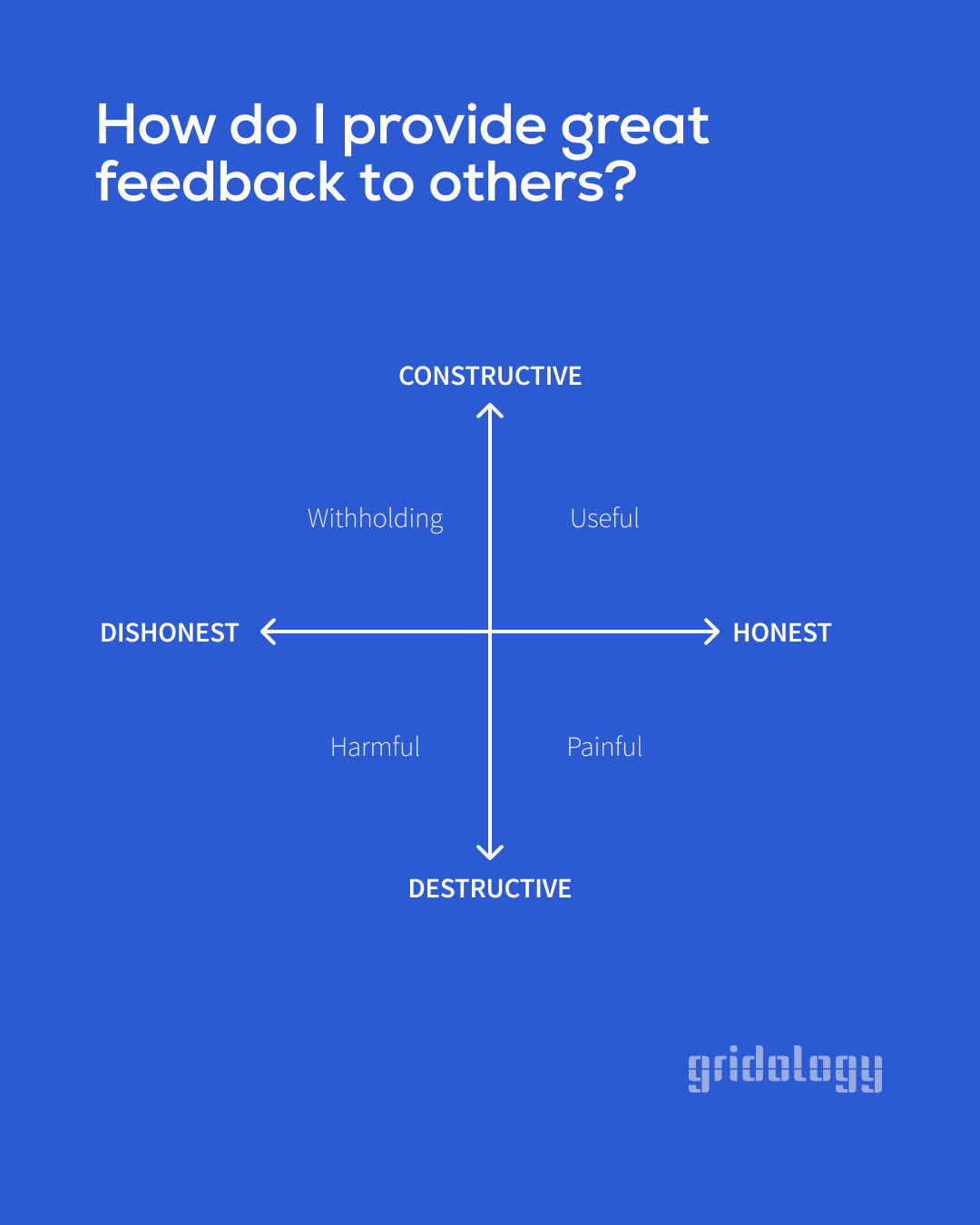For those of you who missed it on Twitter, I shared a behind-the-scenes look as to how Gridology comes together every Sunday. Surprised by the process? Found it interesting? Let me know.


Today’s grid is a necessary follow-up to a post I wrote back in July: How do you incorporate feedback into your life? The previous post was a critical primer—it shared the importance of both giving and receiving feedback. Where it lacked, however, was explaining how to actually give effective feedback to others and how to act on feedback yourself. I’m tackling the former today.
Finally, before we start talking about feedback, just one more thing: It’s been a long time, friends, since I’ve read something that feels different. It’s not about politics, coronavirus, business, or productivity. It’s just beautiful, crisp writing. Tom White is a wonderful storyteller and a magnificent writer. I cannot recommend his newsletter White Noise enough. I couldn’t stop nodding along reading this post.
And, with all that said, let’s dive in:

Giving great feedback is a learned interpersonal skill. We aren’t born knowing how to make others better. That said, knowing how to deliver great feedback is one of the most important things we can learn how to do.
So we’re all speaking the same language, let’s define what great feedback actually means:
GREAT FEEDBACK • noun
When one person provides honest and constructive criticism to another person, ultimately leading to a marked improvement in the other person’s actions or output.
Great feedback is great because it makes someone better. There’s no other reason to give any feedback unless you are looking to help someone maximize their full potential. Full stop.
It’s best explained with an example. Earlier this week I gave feedback on a buddy’s essay for his business school application. There were many incorrect ways I could have given feedback. Here are just three:
I could have delivered the cold, honest, brutal truth and told him that the introduction and the conclusion were weak and that he should fix it (painful)
I could have lied, told him it was nearly perfect and provided a handful of grammatical edits (withholding)
I could have lied, and told him it was flaming garbage and that he should just delete the document and try again (harmful)
Instead, I gave useful feedback: I told him that there were some elements that were fantastic—I loved the examples he shared and the narrative he weaved—but there were parts in the introduction, conclusion, and some bits of the story that weren’t as hard-hitting as they should have been. I didn’t stop there. I then offered suggestions for how he could improve it. I treated his essay like it was my own.
Giving great feedback requires finesse, honesty, and utility. I first learned this model working at LinkedIn. One of the company values is to be open, honest, and constructive. This post dissects exactly what that really means.
On the x-axis, we have how honest you are. Great feedback must be honest. That means it must be true. To give dishonest feedback is a disservice and a waste of time for all parties involved. You are not doing anyone any favors by sparing them the truth around how they are acting or the work they are creating. Your feedback is being requested because it matters. Deliver the truth.
On the y-axis, we have how constructive you are. Great feedback must be constructive. Said differently, it must strive to improve. To give feedback that’s destructive would mean that if someone was to act on your suggestion, they’d be worse off than where they began. In my view, destructive feedback can also ruin morale without offering ways to make something better. If you just tell someone they are wrong or their work is bad, what’s their logical next move? It’s to feel bad about themselves or their project. Flip the script, and ensure you are always providing constructive feedback.
Understanding the Grid
The goal of this grid is to ensure your feedback is always honest and constructive. As I mentioned, this is the most useful feedback someone can receive. All other types of feedback should never be used. There’s no place for them, they don’t contain value, and they don’t work to improve whoever or whatever you’re critiquing.
Useful
Your feedback is both honest and constructive. This is the gold standard. Useful feedback is great for two reasons. First, the person receiving it can make a real, distinguishable change after hearing it. This type of feedback is actionable. There are specific areas where someone can direct their improvement efforts. Usually, with a few tweaks or with a little practice, the proposed gain can be realized. Second, it makes you—the person giving the feedback—feel great. Helping others maximize their potential often feels better than helping ourselves.
For example, my fiancé, Casey, recently provided me with some useful feedback. Given we’re just one and half months into being dog parents, we’re still figuring out our roles and routines. To be honest, at times I’ve fallen short of living up to my share of the duty—work, writing, and exercise have gotten in the way. Casey told me that I had to step up my game during the daytime. She offered tangible ways I could improve. When I wasn’t on calls, I could do my work near Murray so she could have a break. I could take the early morning walking shift before I began my day. Straight up, I needed to clean up more potty accidents. She delivered her honest feedback in a constructive way. Things have been better since. Obligatory dog picture before we continue:

Painful
Your feedback is honest but destructive. Most of the time we don't aim to be destructive—so when your feedback lands in this quadrant, it’s an accident. You need to find ways to be more constructive, compassionate, or helpful. Put yourself in the other person’s shoes. If you were to receive the feedback you are about to give, would you accept it with open arms or would you get angry and shut down? Painful feedback can’t be great feedback. The receiver of the feedback is so focused on why that person said something in such a painful way that the critique gets rejected. Instead, the person should be focused on how the feedback can be digested and resolved.
Or, the feedback could just be vague. The easiest example is when you would receive graded essays in school and there would be no writing on the page except for a big letter or number. In any situation where the grade wasn’t a perfect score, you should feel bothered. What did you do wrong? What could you have improved to get a better grade? In order to make this painful feedback useful, the teacher would have needed to point out areas in the essay that fell short and explain how he/she would have fixed them.
Withholding
Your feedback is dishonest but constructive. While constructive, you avoid telling the whole story. Since you aren’t telling the whole truth, you’re being dishonest. Since you’re being dishonest your feedback isn’t as useful as it can be. Most of the time this feedback comes in the form of white lies. The person giving feedback fears what will happen if the full truth is told. The biggest fear I have when I catch myself providing unhelpful feedback is that what I say could hurt the other person’s feelings. In these cases, I look to caveat my feedback with phrases such as “you may want to try” or “I don’t mean to be mean, and please don’t take this the wrong way, but…” Ultimately, remember, the goal of providing feedback should be to make the other person better. If your feedback strives to do exactly that, you should always try to be as helpful and useful as possible.
In situations where the feedback is intense—meaning the project needs a complete overhaul—giving feedback can feel like a lost cause. In these cases, you should still provide the feedback you need to give. However, you need to do so in a way that prioritizes the most serious areas first. If you can personally relate to the feedback (and explain it isn’t about them but the style that’s needed for the project) it helps cushion the blow. Plus, most of the time, the real reason the feedback is that intense could be for a different reason: there could have been a miscommunication, an unforeseen time crunch, or a missing skill.
Harmful
Your feedback is dishonest and destructive. This is the quadrant of spiteful and jealous people. If someone is accomplishing something that you envy, you may be less prone (deep down) to want to help them succeed even more. In fact, you may try to hurt their success by offering lies designed to make them regress. Bleak. I know. When you operate harmfully, you become a hater. If you ever find yourself here, remind yourself of the old adage, “if you have nothing nice to say, say nothing at all.” Life is much too short to be knocking people down. If this is someone you care about or work with, making them worse off hurts you in the long run, too. Life is a team sport and we are all only as strong as our weakest player. Making someone worse off does not make you better off. This isn’t a zero-sum game.
Grid Shortcomings
This grid ignores how honest and constructive feedback is delivered. Tone matters. In order to give great feedback, the final missing ingredients are positivity and teamwork. Don’t let your great feedback get lost because you delivered it in the wrong tone.
This grid ignores that not everyone is looking for feedback. In order to provide great feedback, the person receiving the feedback needs to be open to it. Nothing feels worse than receiving unprompted feedback. The receiver feels blindsided. Though it may be honest and constructive, it feels like getting the wind knocked out of you. You should always ask before giving feedback.
The best way to improve performance—in life or business—is through feedback.
When we recognize feedback as a tool for improvement rather than shortcomings, it unlocks doors. We can provide so much value to others when we provide great feedback. I hope this formula helps you be a better friend, colleague, and family member.
Life’s only as confusing as you let it be,
Ross
Special thanks to the Compound Writing members who reviewed this post: Richie Bonilla, Diana Klatt, and David Vargas.
If you enjoyed today’s Gridology post, please consider forwarding it to your friends, family, or colleagues. As always, please reply to this note or find me on Twitter if you have any feedback, have ideas for a post, or want to collaborate.



